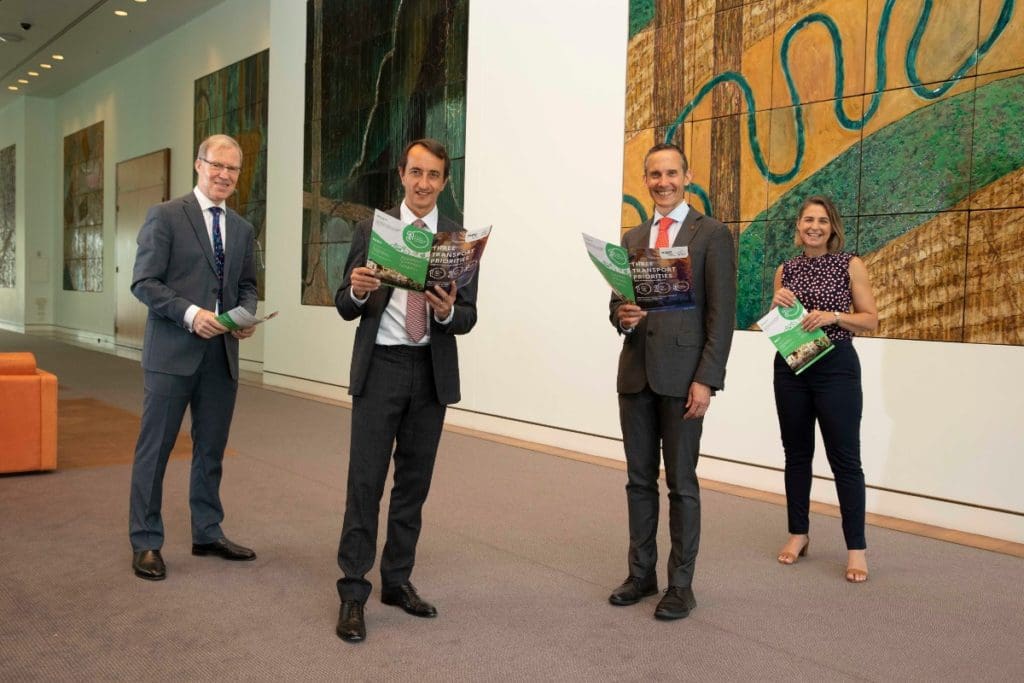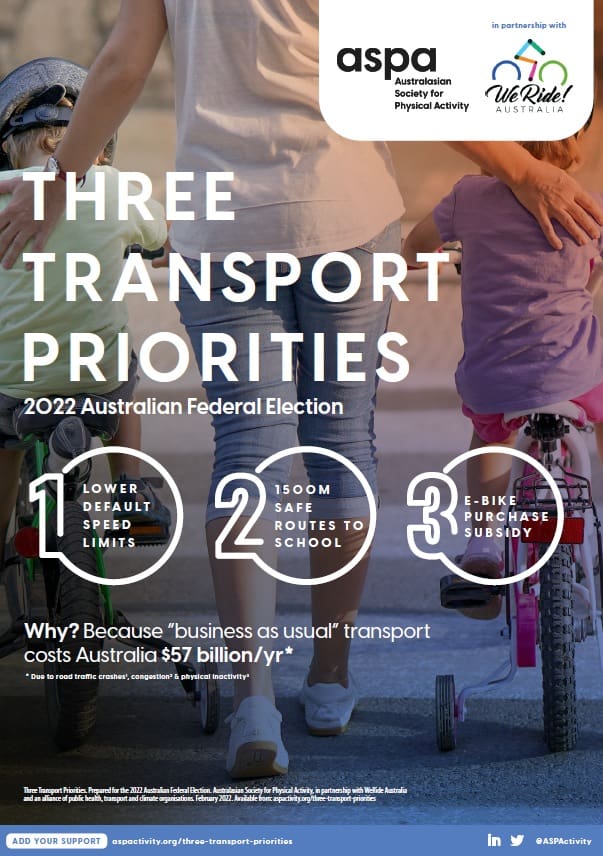We Ride Federal Election Pitch Pushes Three Priorities

Canberra, ACT
Lower default speed limits, safe school routes and a subsidy to buy e-bikes are targetted in a Federal election wish-list jointly prepared by two peak lobby groups.
We Ride Australia and the Australasian Society for Physical Activity (ASPA) on Monday launched their Three Transport Priorities document, in anticipation of the Federal election due to be held in the first half of this year.
Representatives of the two groups presented the document to two co-chairs of the Parliamentary Friends of Cycling group, Liberal Member for Wentworth Dave Sharma and Labor Member for Fenner Dr Andrew Leigh MP. The third co-chair, the Independent Member for Indi, Dr Helen Haines, was unable to attend because of parliamentary business.
The groups’ campaign calls on election candidates to adopt three campaign platforms to promote cycling as a transport option.
It appeals to the next Federal government to:
- use its funding to support States and territories to adopt lower default urban speed limits in residential areas, shopping streets and school zones (on non-arterial local roads), accompanied by enforcement and public education.
- use its funding to support States and territories to implement safe routes and pedestrian priority crossings within 500-1500 metres
- fund a 25% subsidy (up to $1,000) for the purchase of an e-bike
Tackling a $57 Billion Problem
The document states Australia’s transport status quo costs the nation $57 billion a year in traffic crashes, the health impacts of physical inactivity and the effects of traffic congestion, such as lost productivity.
Three Transport Priorities says speed is the number one cause of motor vehicle crashes, with more than 39,000 serious injuries and 1,100 deaths on Australian roads and paths each year.
“In Australia, 13% of crashes could be avoided by reducing speed limits to 30kmh on non-arterial urban streets, resulting in a national economic benefit of $3.5 billion per year,” it says.
“Two-thirds (64%) of Australians support lowering speed limits in residential areas.”
Reducing speed limits to 30km/h is globally recognised as key to saving lives, with a growing number of global case studies showing the benefits of reducing default urban speed limits to 30km/h, “cost-effectively reducing crashes, and supporting people to walk and for ride short journeys”, it adds.
“Lower-speed environments support walking and cycling, reduce traffic congestion, crashes, air and noise pollution, and support physical activity.
“Local businesses benefit from low-speed, walking-friendly streets.”
The joint statement says the safe routes to schools should be accompanied by designated ‘no drop-off’ zones adjacent to, or within, school grounds to enhance safety for all students.
“Four decades ago, three out of four Australian children walked or rode to school. Today, just one out of four walk or ride,” it explains.
“Giving 3.7 million school-aged kids in Australia an active start to life can support them to remain active as adults and to develop independent mobility skills.”
It points to research that suggests 1500-2000m is the ideal distance to walk or cycle to school, with 57% of Australian kids living within 3km of their school. More than two-thirds (71%) are within 5km.
However, road traffic crashes are the number one cause of death for Australian children and half of Australian parents have safety concerns about letting their child walk or ride to school.
“The focus on health provides a powerful way to cut through and it can make the reasons to invest in cycling more relatable”
Stephen Hodge – We Ride Australia
“For the cost of the 9km Sydney NorthConnex tunnel ($3 billion), Australia could build an additional signalised pedestrian crossing within 1500m of every school in the country,” the campaign states.
The campaign’s push for an e-bike subsidy, applied at the point of sale, highlights modelling that shows each dollar invested in $1000 and $500 e-bike subsidies would bring a return on investment of $2.61 and $3.11 respectively.
Current Australian subsidies on e-vehicles exclude e-bikes.
“Upfront purchase price is one of the main barriers to the uptake of e-bikes,” the groups say.
“e-Bikes help reduce congestion, parking frustration, road traffic crashes and physical inactivity.
“Purchasing subsidised e-bikes is accessible and affordable for those with lower incomes.”
Tangible and Popular Solutions
APSA spokesperson Tepi Mclaughlin said: “The Three Transport Priorities are tangible, evidence-based and popular solutions to reduce traffic crashes, reduce congestion and increase physical activity.
“They’re also cost-efficient.”
We Ride’s Director – National Advocacy, Stephen Hodge, said while We Ride and ASPA partnered to produce and launch the document, the campaign was backed by an alliance of 13 national health, transport, education and climate organisations.
He said that alliance was imperative to give the document’s strategies more traction and provide a greater platform for politicians looking to stand up in support of active transport.
“All the members of all the cycle organisations in this country make up about 3% of people who ride a bike in Australia; so it’s strategically imperative we align ourselves with broader issues and with bigger players,” Stephen said.
In particular, it was vital to underpin the campaign with an emphasis on health and wellbeing – and APSA brought links to many health experts and organisations.
“The focus on health provides a powerful way to cut through and it can make the reasons to invest in cycling more relatable,” he said.
“At the same time, the alliance is recognition that cycling can play a part in many solutions and many societal issues and government policies.”
He said while the Three Transport Priorities and its launch this week would struggle to gain mainstream media coverage, amid the many other issues taking centre stage, it would play a valuable role in equipping politicians in their campaigning and position the three priorities to be part of broader conversations.
“We are giving politicians a platform to be seen to be supporting cycling,” he added.
The priorities also offered solutions for other transport related issues, such as the Federally-driven National Road Safety Strategy – an agreement between the Commonwealth and States – and a current shortage of school crossing attendants in WA, following recent incidents that have stopped a number of people from taking on the role.
The Three Transport Priorities document was also endorsed by 11 other national organisations including the Heart Foundation, Amy Gillett Foundation, AusCycling and the Climate Council.
Greens Party Platform
The Australian Greens Party released its Federal election platform this month, including an extra $500 million per year to make “cycling and walking safe and accessible”.
Current opinion polls indicate both major Parties will struggle to secure a clear majority of seats in the lower house during the upcoming election. A minority government would give the minor parties and independents greater influence in the policy priorities and decision making during the next term of government. With the polls also showing a slight firming of support for the Greens, they could gain a little more muscle to push their policy agenda.
Join the Conversation:
Has the campaign got it right with the three priorities?

